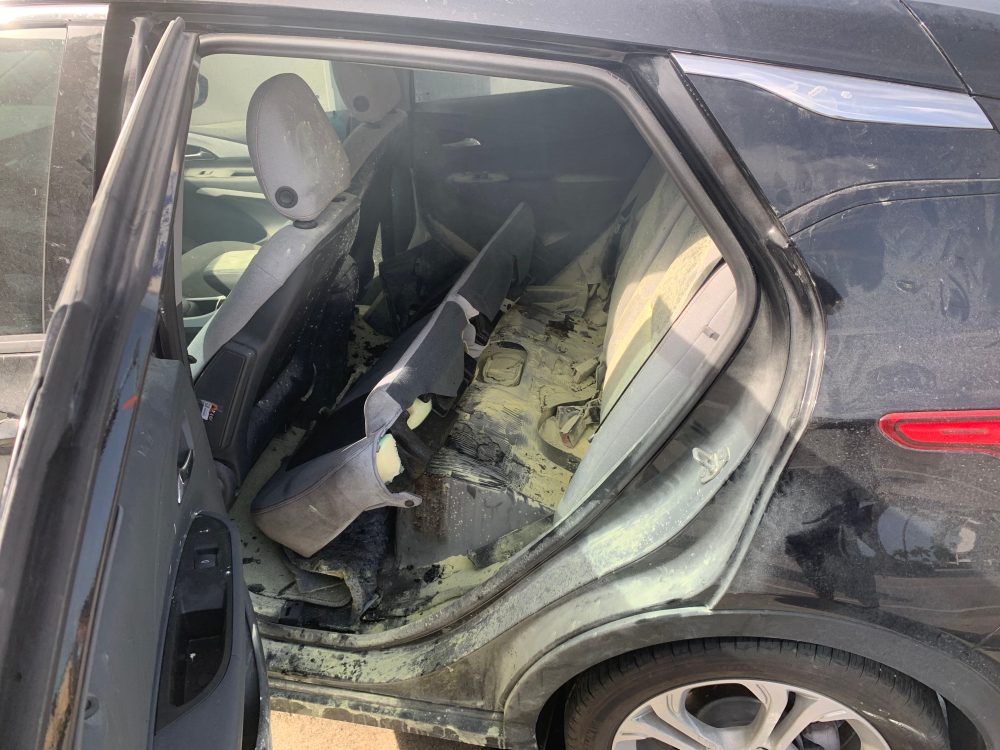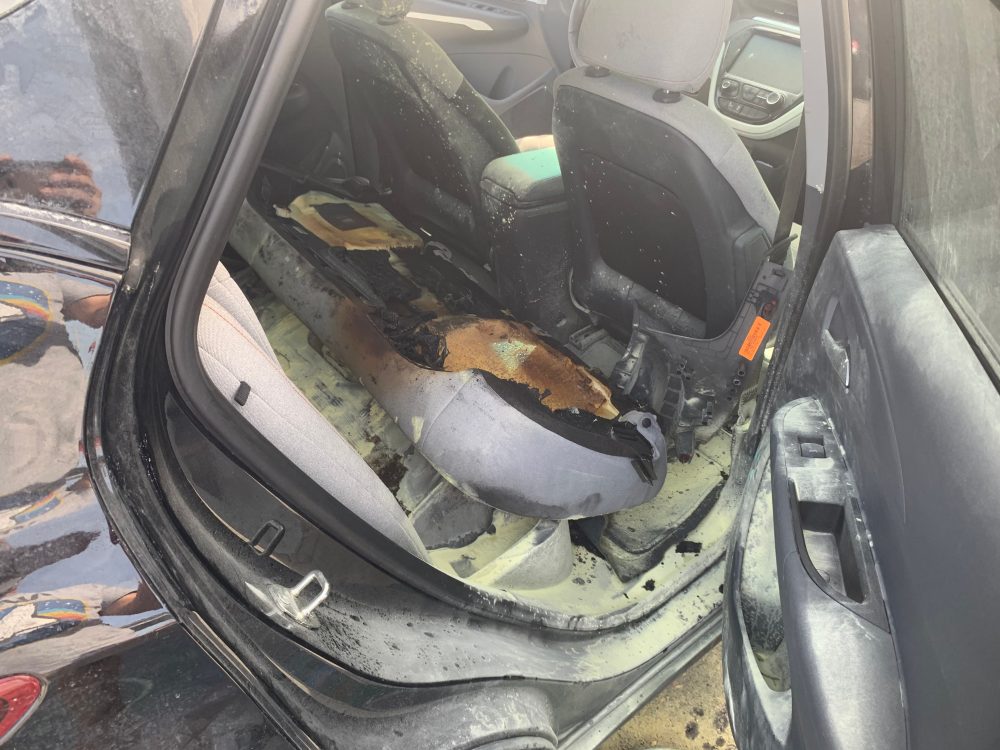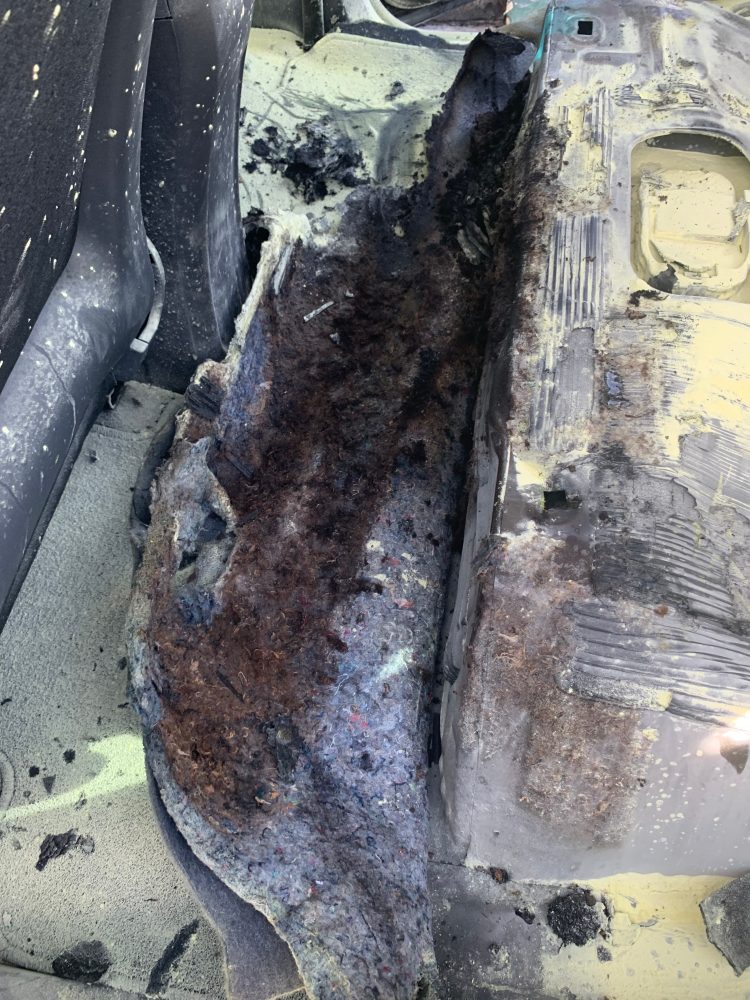
Details are emerging from a dozen Chevy Bolt EV fires that have occurred in a little over the past year. Electrek sat down with the owner of one of the first to get his story. More than a year later, he is still making car payments on a car he doesn’t own. GM confirmed his case to be a battery fire.
GM again exploded into the mainstream news last week with an announcement that it was no longer safe to charge the Chevy Bolt EV unattended and that owners should park outside and away from structures out of fire concerns. This all started with a recall of 68,000 Bolt EVs in November of last year. While Hyundai had a similar problem and eventually elected to replace all Kona EV batteries with newer ones, GM decided that software could fix their problems. There have been at least two Bolt EV fires that had the final software update installed, which prompted GM’s recent announcement.
We reached out to a GM spokesperson for comment. We were told that GM is diligently investigating these latest fires and is working on a potential update to owners as quickly as possible. But the spokesperson could not give a timeframe for how this would progress.
While some are quick to dismiss electric vehicle fires as still less common than gas car fires, the opposite is actually true in this particular case. The Chevy Bolt, at least the 2019 model year, is more than an order of magnitude more likely to catch fire than a 2019 gas car, and it can do so in the middle of the night when you’re sleeping.
Electrek exclusively sat down with several owners of Bolt EV fires, and here’s one of their stories.
This is the owner’s recount from his Bolt EV fire that occurred on June 29, 2020, that GM confirmed to be battery-related.
Scott really loved his car
This is a refrain we hear from all Bolt fire victims. They really loved their car.
Scott was cleaning out his car the morning of June 29, 2020. He had to take it to a local body shop for some minor roof paint repair work. He remembers thinking to himself, “I can’t believe how much I love this car,” as he removed a few personal effects, leaving it nearly spotless. The only thing that remained in the rear seat was his son’s infant car seat. It had only been a few months since he brought his son home from the hospital.
I remember having the best feeling in the world as I placed my son into his car seat for the first time. This was a stable, safe, and clean car for my family. I was doing something right, I was a part of the solution. Driving clean so that I could provide my son with a future.
Indeed, Scott was a self-described EVangelist. “I told everyone who would listen how amazing how awesome this car was. It was the best move that I ever made,” he recounted. He had intended to own a new one of these every 3-4 years. It was the best car that he had ever driven, and he couldn’t see himself driving anything else.
One last night
Like usual, Scott had plugged the car in the night before to his L2 ChargePoint unit. He thinks that it had about a third of a charge remaining. He always used the car’s time-of-departure charging so that the battery would be full around 7 a.m. Scott had driven the car about 21,000 miles in the year and a half that he owned it. He actually enjoyed the long trips he would take for work, some days driving more than 150 miles before getting home. Most of the time, he would plug in around 30%, almost never plugging in above 50% — a refrain we’ve heard from almost all of the fire victims.
Leaving around 10:30 a.m., he had to run a few errands and dropped the car off at the body shop around noon. He had only drive around 7-8 miles, so the car was still nearly at a full charge. His wife picked him up and drove him home.
Then, an emergency call
A little more than four hours later, he notices a missed call from the body shop with a text message saying, “Emergency re: your car — call immediately.” It turns out that before the body shop even had a chance to look at the car, there was an awful acrid smell, and it started to smoke. The fire department was called and showed up just before 4:30 p.m. One big problem — they didn’t know how to deal with an electric vehicle fire. Scott had to 3-way call the dealership so that they could tell the firefighters how to cut the wires to ensure their safety. They removed the back seat and sprayed some water on the battery, then doused the back seat with dry chemical fire suppressant and left a little more than half an hour later as the smoke had stopped.
Scott arrived around 5:30, took pictures, and called his insurance company to file a claim. They said that they could send a tow truck to pick it up the following day.
The car was a mess from the chemical spray, and what still sticks out in my mind to day is the image of my son’s car seat, melted into the rear seat. I kept thinking what if my son had been in there?
After about 20 minutes, he left, thinking that was it. Well, at least he’d get a new car — after all, that’s what insurance is for, and the battery was under warranty.
Not so fast.
Just minutes after getting back home again, he gets a call at about a quarter after six. The car had reignited. The shop owner took a video while he was waiting for the fire department — the only thing that he could do was use a garden hose.
Rushing back, the fire department was already on site but didn’t know what to do. The owner of the body repair shop was understandably upset since the entire inside of his shop stunk from the smoke. The insurance company was freaking out and told Scott to tow it back to his house (yes, despite the fact that it was still smoldering). Instead, the fire department winched it to a nearby parking lot and tried for four hours to put it out:
E23 was called back to the scene of a previous electric car fire, apparently a rekindle of the same car which crew had just put out 30 minutes prior. On arrival the same vehicle was once again smoldering. Crew began fire attach with all resources including water, foam and dry chem extinguishers. Although a lot of headway was made attacking the smoldering batteries, the battery compartment which was hard to get to was still smoldering after 4 hours of different fire attack tactics.
Fire department report description of the second call
Then things got really bad for Scott
As if all of that wasn’t bad enough, the ensuing battle to deal with this was exhausting. It shouldn’t have been that big a deal — at least nobody was hurt, and it was away from home. He thought that at least he’ll get a new car out of the situation. The car has an eight-year battery warranty and was fully insured.
Well, it didn’t work out that way. Scott says that he fought with GM for three weeks. The dealership “ghosted” him and refused to provide needed documentation. GM didn’t respond to calls, then sent him an email claiming that it couldn’t reach him. Despite all this, he finally had enough details to settle with the insurance company.
The main problem? No gap insurance. He owed $32,964 on the car, and the insurance appraised the vehicle at just over $21,000. Because of all of the steep discounts that GM was offering on the Bolt, his 18-month-old car was worth about half what he paid for it.
Scott was left with a little under $12,000 in debt because of his battery-related Bolt EV fire and thus couldn’t even afford a replacement car. One of the major selling factors of an electric vehicle is that it’s supposed to save you money. Now, he’s in debt.
GM would not help him
Calling GM back to complain about this, he questioned why this was even necessary. He bought this car knowing that GM would stand by the battery for eight years. Regardless of what happened, it would be covered by warranty, the dealership assured him when he bought it. The entire purpose of a warranty is so that the manufacturer will replace or repair a product if there is a defect. GM has admitted there is a defect, so clearly, this should be covered under warranty, or so he thought.
Instead, this is what Scott says that GM told him:
Fire voids the warranty
GM’s response to why it wouldn’t cover repairs or replacement of the battery or car.
The car was not a total loss — it sold at auction as “REBUILDABLE.” But because of the Bolt EV fire, GM refused to honor its warranty. As Scott protested, he was shut down. They told him that the only way that GM would be willing to investigate further is if he sued them. At that point, he says that his case was closed.
Left In Debt
After getting the payout from the insurance company, Scott still had $12,000 still owing on the debt. Even worse, he had no car to show for it. He felt that he couldn’t afford to sue GM. There’s no guarantee of a favorable outcome when suing a company that large.
GM wouldn’t help me and dismissed my case, telling me to sue them. The dealership avoided me. This took a spectacular amount of time in the middle of COVID and with a 3 month old. I had to take time off work. It took weeks of my life trying to deal with this, just to wind up $12k in debt.
It’s impossible to have a worse taste in my mouth over GM and Chevy products, period. I really want to drive electric. But I will never, ever buy another General Motors vehicle for the rest of my life based on how they treated me.
Scott is still paying off the debt today. He eventually had to borrow money from family just so that he wouldn’t have to be reminded every two weeks as the loan payments came out of his bank account.
The thing that I just can’t get over is how my son’s car seat was in the back seat. It was attached just above the battery where the fire happened. I am so incredibly thankful that nothing ever happened to him while he was in there.
He could have had gap insurance. Scott could have taken the payout and bought another used Bolt or even a Leaf. But after all that happened, he was understandably reluctant to get into another electric vehicle. Instead, he has returned to driving his diesel pickup, despite really disliking it. It made more sense to him to put the money into paying off the debt and wait for the technology to mature.
Scott didn’t share his story until now because he didn’t want to dissuade others from buying an electric vehicle. He’s not looking for a handout. He didn’t want to whine about the money. He doesn’t even care if he gets another penny out of them. But after seeing the fires that keep occurring, he wants GM to stand up and do what’s right.
Electrek’s Take
This is an insane story, and it’s easy to feel Scott’s pain. Nobody should have to go through what Scott had to endure after his Bolt EV fire. The car was supposedly repairable and sold at auction for over $10,000. GM should have just replaced the battery and cleaned it up or given him a replacement car. To shut down his inquiries and just tell him to sue them is reprehensible.
In GM’s original filing with the NHTSA for the recall, the company confirmed his battery fire. Scott has had to relive this for more than a year. Every time he heard about another Bolt EV fire, all of this frustration resurfaced.
Yes, he could have had gap insurance (hindsight is 20:20). Yes, he could have just bought another EV. But can you blame him for not wanting to after how he was treated?
What’s even worse? GM has been doing buy-backs and MSRP swaps. Scott has been hearing how GM is giving some owners a brand new 2022 Bolt with a check because the 2022’s are less expensive than the 2019s were. They’re literally paying some people to take a new car out of the risk of a battery fire. However, they have left Scott — who actually had a battery fire — with $12,000 in debt. They also apparently haven’t helped out the owner of the May 1 fire, who says that his insurance won’t pay out or start repairs on his house until GM concludes their investigation. (We reached out to GM about this, as there are always two sides of the story, and were told that the company is looking into it.)
How would you feel in Scott’s position after having a Bolt EV Fire?
GM needs to do the right thing. Make all of the Bolt fire victims whole, work with their insurance, pay off any debts, and replace their vehicles. It’s the least that they can do based on the inconvenience and the stress and worry that they’re under now. GM also needs to offer all the affected owners either a battery replacement or a new Bolt so that these fires don’t keep happening.
It wouldn’t even cost them that much. If GM reached a similar settlement that Hyundai did with LG, it should cost them around $250 million to replace all of the affected batteries. This may sound like a lot, but don’t forget that GM is expecting $10 to $11 billion in profit this year. That’s less than 3% of their profit.
GM’s All Electric Future At Risk
There are more owners like Scott who are swearing off GM based on how the company is handling the Bolt EV Fire recall. It wasn’t even that long ago that GM had another major problem to deal with — the faulty ignition switch scandal.
GM’s CEO, Mary Barra, had her “Pearl Harbor” moment after it was discovered that GM had “a pattern of incompetence and neglect” that led to the deaths of at least 13 people.
“Our job is clear: To build high quality, safe vehicles, In this case with these vehicles, we didn’t do our job. We failed these customers. We must face up to it and learn from it.”
“But I never want to put this behind us. I want to keep this painful experience permanently in our collective memories. I don’t want to forget what happened because I — and I know you — never want this to happen again.”
Mary Barra addressing a town hall of GM employees, Thursday June 5, 2014.
She also said that “In fact, I never want you to forget it. This is not just another business crisis for GM. We aren’t simply going to fix this and move on.” But it seems that is exactly what they did with the software fix for the Bolt. Luckily nobody has been injured or died, but with cars that burst into flame in the middle of the night, how long until that happens?
Now’s your time, Mrs. Barra. As GM forges ahead into its all-electric future, let’s hope that you haven’t forgotten.
FTC: We use income earning auto affiliate links. More.






Comments